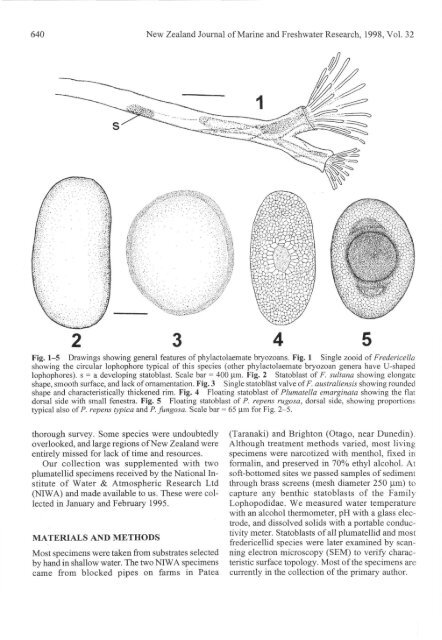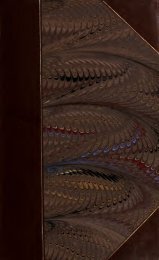640 <strong>New</strong> <strong>Zealand</strong> Journal <strong>of</strong> Marine and <strong>Freshwater</strong> Research, 1998, Vol. 32Fig. 1-5 Drawings showing general features <strong>of</strong> phylactolaemate <strong>bryozoans</strong>. Fig. 1 Single zooid <strong>of</strong> Fredericellashowing the circular lophophore typical <strong>of</strong> this species (other phylactolaemate bryozoan genera have U-shapedlophophores). s = a developing statoblast. Scale bar = 400 um. Fig. 2 Statoblast <strong>of</strong> F. sultana showing elongateshape, smooth surface, and lack <strong>of</strong> ornamentation. Fig. 3 Single statoblast valve <strong>of</strong> F. australiensis showing roundedshape and characteristically thickened rim. Fig. 4 Floating statoblast <strong>of</strong> Plumatella emarginata showing the flatdorsal side with small fenestra. Fig. 5 Floating statoblast <strong>of</strong> P. repens rugosa, dorsal side, showing proportionstypical also <strong>of</strong> P. repens typica and P.fungosa. Scale bar = 65 um for Fig. 2-5.thorough survey. Some species were undoubtedlyoverlooked, and large regions <strong>of</strong> <strong>New</strong> <strong>Zealand</strong> wereentirely missed for lack <strong>of</strong> time and resources.Our collection was supplemented with twoplumatellid specimens received by the National Institute<strong>of</strong> Water & Atmospheric Research Ltd(NIWA) and made available to us. <strong>The</strong>se were collectedin January and February 1995.MATERIALS AND METHODSMost specimens were taken from substrates selectedby hand in shallow water. <strong>The</strong> two NIWA specimenscame from blocked pipes on farms in Patea(Taranaki) and Brighton (Otago, near Dunedin).Although treatment methods varied, most livingspecimens were narcotized with menthol, fixed informalin, and preserved in 70% ethyl alcohol. Ats<strong>of</strong>t-bottomed sites we passed samples <strong>of</strong> sedimentthrough brass screens (mesh diameter 250 (im) tocapture any benthic statoblasts <strong>of</strong> the FamilyLophopodidae. We measured water temperaturewith an alcohol thermometer, pH with a glass electrode,and dissolved solids with a portable conductivitymeter. Statoblasts <strong>of</strong> all plumatellid and mostfredericellid species were later examined by scanningelectron microscopy (SEM) to verify characteristicsurface topology. Most <strong>of</strong> the specimens arecurrently in the collection <strong>of</strong> the primary author.
Wood et al.— <strong>Freshwater</strong> <strong>bryozoans</strong> <strong>of</strong> <strong>New</strong> <strong>Zealand</strong> 641RESULTSAltogether we visited 46 sites in the North and SouthIslands, including rivers and lakes <strong>of</strong> various sizesand trophic conditions. <strong>Bryozoa</strong>ns were found at 39<strong>of</strong> these sites, including at least one species not previouslyreported from <strong>New</strong> <strong>Zealand</strong> (Tables 1 and2, Fig. 6). Each species is described below in order<strong>of</strong> decreasing frequency <strong>of</strong> occurrence.Fredericella sultana (Blumenbach, 1779)(Fig. 1,2)Fredericella sultana was found at 62% <strong>of</strong> all siteswhere <strong>bryozoans</strong> occurred, making it the commonestspecies encountered. When Dendy (1906) firstreported this species at Christchurch, Annandale(1911) had not yet described F. indica. <strong>The</strong> twospecies are distinguished only by their statoblasts,which are smooth in F. sultana but deeply pitted inF. indica (Wood & Backus 1992). Both species arewidely distributed: F. sultana in Europe and Asia(Lacourt 1968), F. indica in India (Annandale 1911),North America (Wood & Backus 1992), and recentlydiscovered in Germany (Massard & Geimer 1995).We confirm that the fredericellid species in <strong>New</strong><strong>Zealand</strong> is indeed F. sultana.Unfortunately, statoblasts were scarce in the <strong>New</strong><strong>Zealand</strong> material, even in the very large colonies.Nearly half <strong>of</strong> our specimens had no statoblasts atall and thus cannot be positively identified, althoughwe expect they are the same species as our morecomplete specimens. All <strong>of</strong> the statoblasts we examinedbear a very faint pebbly texture <strong>of</strong> slightly raisedbumps. <strong>The</strong>se are easily visible using reflected lightmicroscopy on dry specimens. However, we judgethese to be not significantly different from typicalF. sultana statoblasts from Europe and Asia.Table 1 Distribution <strong>of</strong> bryozoan species on North Island, <strong>New</strong> <strong>Zealand</strong>, with data on water temperature, pH, andtotal dissolved solids (TDS). FSUL = Fredericella sultana, PART = Paludicella articulata, PEMA = Plumatellaemarginata, PX = unnamed plumatellid, PTYP = Plumatella repens typica, PRUG = Plumatella repens rugosa, PREP= specimens lacking sufficient floatoblasts to distinguish the specific form.Region and siteTemp. (°C)pHTDS (uS)SpeciesAucklandAuckland, Auckland DomainHunua Falls, 2 km NE HunuaManawatu-WanganuiMangaone River, 6 km S KaitawaMangawhero River, 15 km SW OtokoMt. Bruce Centre, 9 km SW EketahunaOroua River, 3 km E FeildingPa Creek, 15 km S PahiatuaMangawhero River, 3 km SW OreoreTaranakiFarm Pond, near PateaWaikatoOkere Falls, 16 km NE RotoruaLake Atiamuri, 22 km SE TokoroaL. Otamangakau channel, 8 km NW TurangiLake Otamangakau, 14 km E TurangiLake Rotoaira outlet, 8 km NW TurangiOhau channel, 14 km NE RotoruaLake Tarawera, 14 km SE RotoruaWaikato River at HamiltonHamilton, university campusLake Karapiro, 6 km SE CambridgeLake Rotoaira, 12 km WSW TurangiWellingtonLake Wairarapa, 14 km WNW MartinboroughLake Wairarapa, 25 km WSW MartinboroughWellington, Botanic Gardens_222121_281819-2323216920242322-23-1916-• —8.18.77.7_8.07.28.0-7.87.68.78.77.28.48.67.6-8.2-7.77.3-_134320-152716-2019151615215023-18-8130-PTYPFSULPXFSUL, PRUGPEMA, PRUGPREPFSULFSULPRUGFSULFSUL, PRUGPEMA, PRUGPEMA, PRUGFSULFSUL, PRUGFSULFSUL, PREPPEMA, PRUGFSULPRUGFSULPRUGPEMA, PRUG
















